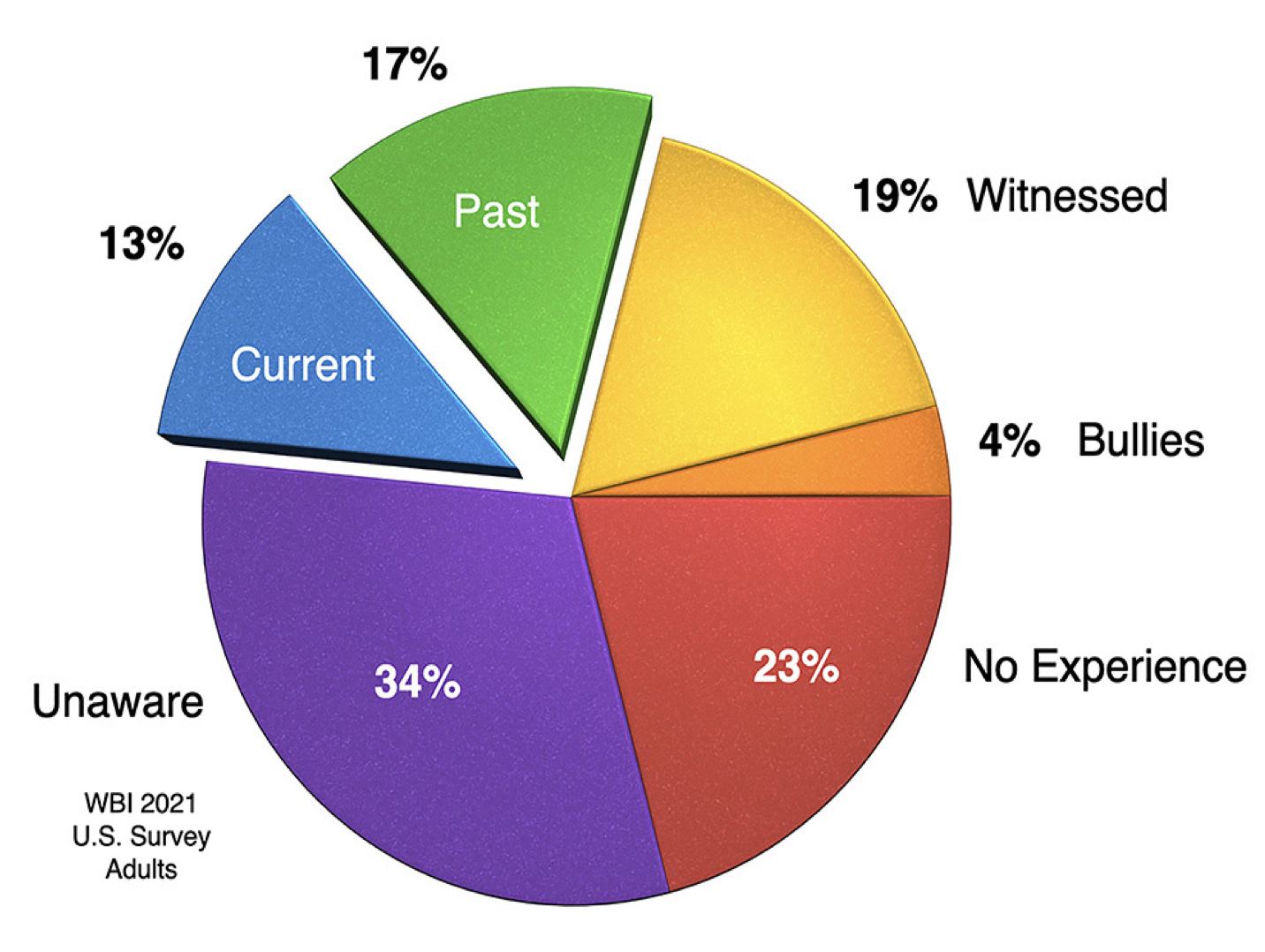October 17, 2023 | By Megan VanMeter, ATR-BC, LPC, LMHC, LPC-AT/S
October 15-21 is International Workplace Bullying Awareness Week in 2023. This week marks the acknowledgement of psychological terrorism and relational violence that occur in paid and unpaid occupational capacities, and it highlights the social injustice of power structures that are rooted in colonialism but continue to flourish in the present day.
Learn more about workplace bullying and treatment considerations during an AATA Continuing Education session with Megan VanMeter on November 18.
Most therapists aren’t aware of workplace bullying as a type of trauma. Even though many targets of workplace bullying wind up in therapy due to anxiety, depression, and PTSD, therapists generally aren’t educated about the widespread practice of this abuse. In the U.S. alone, 30% of the population has experienced it directly and another 19% has experienced it vicariously, according to a 2021 survey conducted by the Workplace Bullying Institute.
And because therapists often don’t understand the mechanisms of workplace bullying, they don’t have the context necessary for helping traumatized clients retain or return to employment. Common outcomes for targets are career derailment, career abandonment, income loss, the depletion of savings, increased health issues, increased medical costs, disability, and even death by suicide.

30% of American workers have experienced workplace bullying directly.
In 2002, France made workplace bullying a criminal offense (Yamada, 2020), but in most countries—including the U.S.—there are no similar legal protections in place for targets. That is why targets largely suffer in silence, with no clear recourse for their occupational and financial losses or for the secondary losses of belonging to oneself and one’s community (Suskind, 2023). Targets cannot publicly name their bullies or the institutions that permitted, and thus promoted, the abuse. Doing so would put targets at risk for legal problems.
Gaslighting, making someone look bad in front of others, setting someone up to fail, ostracizing, excluding, and mobbing are some of the tactics used in workplace bullying. If you recognize that a client is on the receiving end of these insidious behaviors, you may want to direct the client to resources. The Re-VISION newsletter, authored by Dorothy Suskind, PhD, is a great starting place for targets to gain supportive clarity around the abrasive and abusive mystery they’ve been subjected to. At the opposite end of the spectrum, the National Workplace Bullying Coalition’s website is an opportunity for targets to learn about the advocacy efforts aimed at ending this atrocity that affects working people of all ages; knowing that others are taking action in this way can be reassuring and offer hope.
Today I graduated a happy, healthy client who had entered treatment as a depressed, distressed individual. She was already post-workplace bullying by the time we met, and her situation had involved psychological as well as physical violence. As she thanked me for our journey together and her restored sense of belonging, she pointed out that the thing she was most appreciative of was being educated about workplace bullying. Prior to that she had assumed that work was inherently difficult and demoralizing. Her history of childhood trauma had taught her that it was ok to be treated poorly by others. Through treatment she realized that she had experienced a nameable trauma while giving her services as a helping professional, and she experienced it at the hands of someone who had power over her in an institution that was supposed to be about making a difference in the lives of others.
Workplace bullying is not about a mean 4th grader on the playground. It is much more sophisticated than that and results in life-altering consequences for targets in all industries. Even art therapists are on the receiving end of workplace bullying. Please think about the toxic experiences you’ve had as an employee, as a volunteer, and/or as a student. Don’t you wish someone had told you about workplace bullying sooner? International Workplace Bullying Awareness Week is a good time to start having conversations about this trauma-hiding-in-plain-sight with clients, colleagues, and anyone you care about. Let’s break the silence.
About Megan VanMeter, MA, LPC (AZ), LMHC (IN), LPC-AT/S (TX), ATR-BC
 Megan VanMeter, ATR-BC, LPC (AZ), LMHC (IN), LPC-AT/S (TX) is an art therapist who serves adults through a virtual private practice. Her career has taken her into behavioral health, correctional, educational, medical, and social services settings, and these shaped her understanding of workplace bullying and its relationship to professional burnout. A former target of workplace bullying herself, she now volunteers on the target resource team of the National Workplace Bullying Coalition, a nonprofit that seeks to promote dignity in the workplace through advocacy and education.
Megan VanMeter, ATR-BC, LPC (AZ), LMHC (IN), LPC-AT/S (TX) is an art therapist who serves adults through a virtual private practice. Her career has taken her into behavioral health, correctional, educational, medical, and social services settings, and these shaped her understanding of workplace bullying and its relationship to professional burnout. A former target of workplace bullying herself, she now volunteers on the target resource team of the National Workplace Bullying Coalition, a nonprofit that seeks to promote dignity in the workplace through advocacy and education.
Megan graduated from the University of Louisville with a master’s degree in art therapy and studied under Expressive Therapies Continuum co-creators Vija Lusebrink and Sandra (Kagin) Graves-Alcorn; she regularly presents on topics related to the ETC and has a newsletter for expressive therapists who want to be kept abreast of ETC learning opportunities and publications. See https://www.meganvanmeter.com/for-expressive-therapists for more information.
References
Suskind, D. (2023). Workplace bullying: Finding your way to big tent belonging. Rowman & Littlefield Publishers.
Workplace Bullying Institute. (2021). 2021 WBI U.S. workplace bullying survey. https://workplacebullying.org/2021-wbi-survey/
Yamada, D. C. (2020). Bullying and the law: Gradual progress on a global scale. In Einarsen, S. V., Hoel, H., Zapf, D., & Cooper, C. L. (Eds.), Bullying and harassment in the workplace: Theory, research and practice (3rd ed., pp. 628-649). CRC Press.
